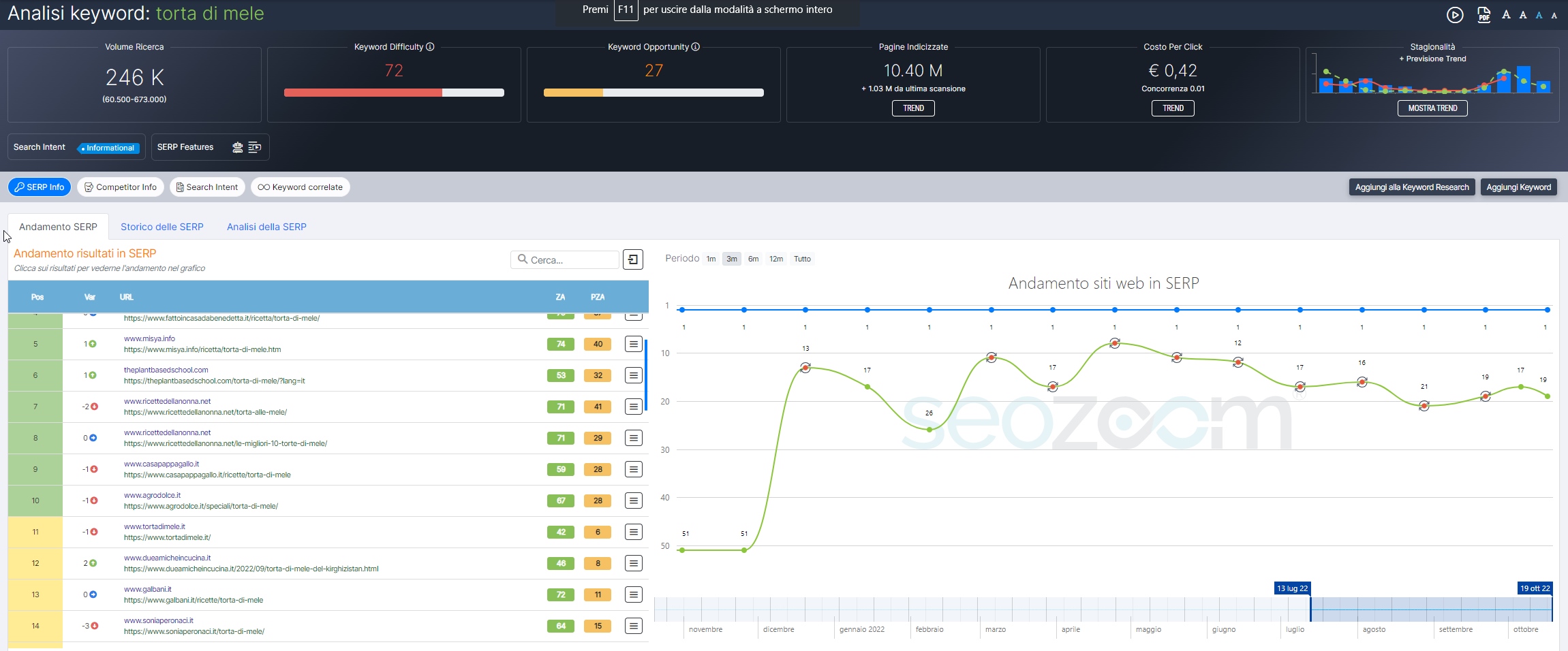Keyword cannibalization: when a site competes against itself
It is called keyword cannibalization, and it is one of the main critical issues encountered when managing a site dense with pages and articles and keyword research to find new insights is not performed optimally. Let’s try to find out all about this phenomenon, which basically generates pages on the same site that compete with each other and risk compromising the performance of the entire domain.
What is keyword cannibalization
As the term “cannibalization” suggests, keyword cannibalization identifies a problematic factor for SEO, namely, the presence on the site of URLs that compete for the same keywords, and thus pages that are similar in content and, above all, in keywords identified and positioned by Google.
It is so called because the site is “cannibalizing” its results by dividing CTR, links, content and (often) conversions between two or more pages instead of one, as would be more logical and profitable.
Troubling Google with similar content and keywords
Wanting to explain in even simpler words what cannibalization of keywords and content is, we can say that it is the phenomenon that occurs when Google’s algorithms have trouble figuring out which page of such a site to index and then rank for a given keyword, finding precisely at least two competing on the same key, declined in similar topics. Typically, two scenarios occur when this happens: Google alternates between the two pages in its ranking, sometimes favoring one and sometimes the other, or it positions the “wrong” and less efficient one with respect to the desired strategy, causing the entire site to lose overall positioning.
Keyword cannibalization is a risk for sites
Evolutions in Google Search algorithms have somewhat limited an old trend of making sites, namely to focus an article only on ranking for a single keyword or to attempt to do targeting of specific terms on multiple pages, reasoning from the equation “the more pages we have in search results, the more impressions we will receive from users.”
In reality, the situation is often exactly the opposite: targeting on the single keyword can do more harm than good to a site’s SEO, because precisely if multiple pages rank for the same keyword, they compete with each other, dividing the benefits rather than multiplying them.
More importantly, today we nowadays aim (or should) to optimize the work by focusing the content on the users’ search intent, so as to respond to the specific type of need that prompted the person to use the search engine, and it is Google itself that openly sanctions this, including with the recent Helpful Content Update. Moreover, on the practical side, with this more modern approach, it is possible to intercept more keywords with the same content, thanks to the quality of the writing and the ability to include many related terms, including semantically.
Nonetheless, however, cannibalization is still a latent risk, usually due to errors in site structure and poor page hierarchy, and can result in lower CTR for each page involved, reduced site authority, and lower conversion rates than an established page.
Keyword cannibalization in eCommerce and online newspapers
It is good to anticipate that any type of online project can fall into this problem: for eCommerce, for example, keyword cannibalization can occur when there is a blog linked to the main site, whose articles conflict with shop categories or specific pages; another case is that of the same products that differ only in some elements, which are not accurately reported in page development. For blogs and news sites, on the other hand, keyword cannibalization often occurs when an evolving topic is discussed with multiple distinct articles, with the newer one not physically undermining the older, dated one.
When does content cannibalization occur
From a technical point of view, then, keyword cannibalization results from two main errors, made at the metadata or page content level. In the first case, which is more typical of eCommerce provided with many category pages, the phenomenon occurs if Google fails to understand which is the main and general page and which, instead, those dedicated to more specific types of the product. In the other eventuality, however, the issue is more complex because it concerns precisely the topics covered, and therefore the solution to the problem must be carefully evaluated to avoid taking action in a way that penalizes the site.
The SEO effects and risks when confusing Google
As we said, when a site is a victim of keyword cannibalization, it exposes itself to a number of risks such as loss of traffic, indexing and ranking of wrong pages in SERPs, decreased sales and fluctuating rankings, including in terms of Zoom Authority. In practice, it is as if Google initially divides the authority, weight, and value attributed to the site across multiple pages, effectively turning the same site’s content into competitors fighting for rankings and views; likewise, you disperse links and anchor texts, but more importantly, you elevate your Crawl Budget and unknowingly “report” to Google the low quality of the content of your pages, which could lead to a downgrade in terms of rankings.
How to identify keyword cannibalization with SEOZoom
Having succinctly clarified the extent of this inconvenience, let’s come to the good news, that is, ways to nip these critical situations in the bud.
Until recently, the most complex aspect was identifying keyword cannibalization, because the only tool (or at any rate the one most used) was the site: command, one of the advanced search operators on Google. Opening the search engine page, one had to type precisely site: followed by the referring domain and then the potentially cannibalized keyword to get the list of URLs indexed by Google as relevant to the topic.
This is now much easier thanks in part to SEOZoom, which has developed a number of tools that and functions dedicated precisely to managing possible cannibalized pages.
The first specific feature is located within the Project Pages section and allows one to immediately find out, thanks to informative and detailed tables, if there are potentially duplicate pages, that is, competing on the same keywords. Specifically, the list of incriminated URLs expresses, in percentage, the possibility that in Google’s eyes one page is similar to another, while clicking on the “Duplicates” button analyzes which keywords are in common and which pages are competing on the same data.
With these insights SEOZoom does not indicate that the text is duplicated or copied, but simply that, according to the scanning performed, the indicated pages are ranked for the same keywords in a higher or lower percentage.
Launching any Keyword Analysis, moreover, you can get similar information at a glance in the graph about the performance of sites in SERPs: possible cannibalization is signaled by an icon with update arrows calling attention and inviting action because a change in keyword ranking URLs has occurred, with one page taking the place of another since the previous analysis.
The other methods of discovering and avoiding keyword cannibalization-and possible self-sabotage of ranking – are available in the specific table “Pages of the site on the same or strongly related topic” that appears after launching the analysis of a URL and in the tables of the Pages section of the Domain Analysis, in particular with the “Similar Pages” tab that lists precisely the pages ranked for similar keywords and topics (not necessarily certain cannibalization, but still content to be investigated).
How to solve keyword cannibalization
So if, with our suite, it is possible to be up-to-date in time on Google’s difficulty in registering and ranking reference content for a keyword, the remaining part of the work is distinctly practical.
To solve keyword cannibalization there are various strategies, more or less disruptive, and the first technical action is to perform a 301 redirect between the competing pages and the one that is most strategic for us, which therefore becomes the landing point of the redirection. In this way, the search engine should have a clearer idea of which page to point to as a reference to users running queries, and the users/readers themselves may find the information they find more useful (never forget the human factor, even when doing SEO, nor underestimate the value of the experience to be provided to people landing on the site).
The Rel Canonical and content optimization to solve keyword cannibalization
A second option is to use Rel Canonical, as is generally done in cases of duplicate content to specify the URL to be shown in search results in a clear and unambiguous manner. This avenue allows us not to delete content from other pages, but still prioritize what we consider most fundamental to the project.
Third intervention to address and solve keyword cannibalization is the reorganization and optimization of competing content: using, for example, SEOZoom’s other tools (such as the Intent Gap analysis) we can discover keywords not taken into account that, if properly included, could open additional channels of visibility and traffic attraction, but above all differentiate the content of the page from that of the other cannibalized one, focusing in practice on long tail keywords instead of the specific and single keyword and creating a structure of internal links to suggest to Google which page to prioritize.
Solutions for information sites
Then there is another option, particularly useful for news sites, which is to create a single “pillar” article into which subsequent updates also flow, i.e., without creating new pages for each subsequent news story on the case or topic. An alternative, again for online newspapers and related, can be to put individual articles in noindex and leave only the relevant category indexed, which then becomes the one preferred by search engines: if you choose this technique, however, you have to be careful about the level of traffic generated by the pages you will de-index, because if it is high you risk creating a harmful effect to the whole site that may be difficult to remedy.
How to avoid content cannibalization during the keyword research stage
In conclusion: before performing keyword research for generating new content on your site, it is a good idea to pay attention to what is already there to avoid keyword cannibalization and its negative consequences on keyword ranking and the ranking of the entire site.
The process of searching for new keywords or keyword clusters should therefore start with an analysis of the existing, checking in particular whether the pages already present have covered the topic and search intent, and to what extent; if the answer is positive, before creating new content it might be better to optimize the existing pages, using the appropriate tools. In addition, even after creating a new “clean” page, it is always a good idea to verify that unintentional cannibalization has not been created by repeating the path described above.






